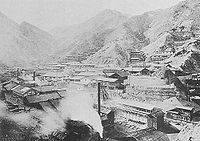
Ashio Copper Mine
Encyclopedia

Copper
Copper is a chemical element with the symbol Cu and atomic number 29. It is a ductile metal with very high thermal and electrical conductivity. Pure copper is soft and malleable; an exposed surface has a reddish-orange tarnish...
Mine
Mining
Mining is the extraction of valuable minerals or other geological materials from the earth, from an ore body, vein or seam. The term also includes the removal of soil. Materials recovered by mining include base metals, precious metals, iron, uranium, coal, diamonds, limestone, oil shale, rock...
, Ashio, Tochigi prefecture
Tochigi Prefecture
is a prefecture located in the Kantō region on the island of Honshū, Japan. The capital is the city of Utsunomiya.Nikkō, whose ancient Shintō shrines and Buddhist temples UNESCO has recognized by naming them a World Heritage Site, is in this prefecture...
, Japan
Japan
Japan is an island nation in East Asia. Located in the Pacific Ocean, it lies to the east of the Sea of Japan, China, North Korea, South Korea and Russia, stretching from the Sea of Okhotsk in the north to the East China Sea and Taiwan in the south...
became very significant from the end of the 19th century to the mid-20th century. It was the site of major pollution
Pollution
Pollution is the introduction of contaminants into a natural environment that causes instability, disorder, harm or discomfort to the ecosystem i.e. physical systems or living organisms. Pollution can take the form of chemical substances or energy, such as noise, heat or light...
in the 1880s and the scene of the 1907 miners riot
Riot
A riot is a form of civil disorder characterized often by what is thought of as disorganized groups lashing out in a sudden and intense rash of violence against authority, property or people. While individuals may attempt to lead or control a riot, riots are thought to be typically chaotic and...
s.
The Ashio mine has been in existence at least since 1600 when it belonged to the Tokugawa shogunate
Tokugawa shogunate
The Tokugawa shogunate, also known as the and the , was a feudal regime of Japan established by Tokugawa Ieyasu and ruled by the shoguns of the Tokugawa family. This period is known as the Edo period and gets its name from the capital city, Edo, which is now called Tokyo, after the name was...
. At that time it produced about 1,500 tons annually, although this declined with the mine being closed by 1800. It became privately owned in 1871 following the industrialisation
Industrialisation
Industrialization is the process of social and economic change that transforms a human group from an agrarian society into an industrial one...
initiated by the Meiji restoration
Meiji Restoration
The , also known as the Meiji Ishin, Revolution, Reform or Renewal, was a chain of events that restored imperial rule to Japan in 1868...
. By 1877 it became the property of Furukawa Ichibei
Furukawa Ichibei
was a Japanese businessman who founded one of the fifteen largest industrial conglomerates in Japan, specializing in electrical goods, chemicals and metals. He bought the Ashio copper mine from the Japanese government in 1877, which he later organized, with his other holdings, into an industrial...
, and by the 1880s production had increased dramatically, reaching 4,090 tons by 1885, 78 per cent of the total output of the Furukawa mines and 39 per cent of Japan's copper production.
The Ashio mine was shut down in 1973.

